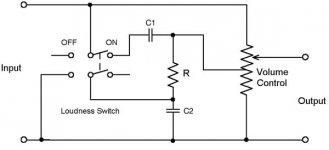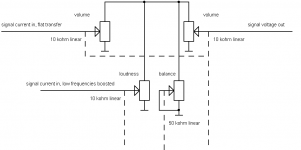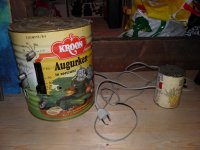Does anyone know a way to introduce a frequency equalizer in the line that changes the equalization curve based on volume.
We all know that we perceive low frequency much less at lower volumes than at high volumes. In 80s, there used to be a bass boost switch that tried to correct for that. But it was a one step boost and not that accurate. Now with digital equalization technology it should be possible to get a flat frequency "perception" or "loudness"
curve at any volume level.
I am hopeful that this is available from some manufacturer. But if it is not, would love to hear why you feel it is not needed.
We all know that we perceive low frequency much less at lower volumes than at high volumes. In 80s, there used to be a bass boost switch that tried to correct for that. But it was a one step boost and not that accurate. Now with digital equalization technology it should be possible to get a flat frequency "perception" or "loudness"
curve at any volume level.
I am hopeful that this is available from some manufacturer. But if it is not, would love to hear why you feel it is not needed.
I have a Yamaha receiver R-S700 that has this feature. Yamaha calls it Continuously Variable Loudness Control. It is a separate knob from the volume control. At the zero detent it does nothing; turning it counter-clockwise decreases the volume and also changes the EQ to add 'loudness'. It's actually nice to have sometimes, when I want to listen at low levels, even without European culture.
The most used method is a loudness control which is a tap on the volume control with some simple frequency circuit (R and C). As you approach low level, you come closer to that tap which gives bass boost.
It is well known that our hearing is less sensitive to low frequencies at low volume - google 'Fletcher Munson'.
There usually was a switch to disconnect that network to defeat the feature.
But there should be a ton of examples online for a loudness control.
Edit - this sums it up nicely, including a sample circuit:
Extron Electronics - The Mysterious Loudness Control: What Does It Do?
Jan
It is well known that our hearing is less sensitive to low frequencies at low volume - google 'Fletcher Munson'.
There usually was a switch to disconnect that network to defeat the feature.
But there should be a ton of examples online for a loudness control.
Edit - this sums it up nicely, including a sample circuit:
Extron Electronics - The Mysterious Loudness Control: What Does It Do?
Jan
Attachments
Last edited:
look for a volume control that has a loudness tap on it. You can add a cap and resistor to adjust how much boost you need at low volumes. as you increase the volume the effect is less and less. Generally past the half way point of the volume control the effect reduces to zero.
If you have trouble finding a volume control with a tap look for a step volume control with external resistors, you can add the tap anywhere.
If you have trouble finding a volume control with a tap look for a step volume control with external resistors, you can add the tap anywhere.
Around 1994 I built a preamplifier with controllable loudness. I passed the unfiltered signal through two mechanically coupled potmeters that served as a volume control. The bass boosted signal went through only one of them, and through an extra potmeter to control the amount of loudness correction. It was all quite easy when you converted the flat and filtered signal into the current domain. It was also easy to add a good balance control.
It also had some disadvantages, though:
1. I needed a quadruple potmeter for a stereo volume control; I simply mechanically coupled two stereo faders.
2. I needed to look out for the noise of the bias current sources of the voltage-to-current converters.
I've attached a simplified schematic and a picture of the finished preamplifier.
It also had some disadvantages, though:
1. I needed a quadruple potmeter for a stereo volume control; I simply mechanically coupled two stereo faders.
2. I needed to look out for the noise of the bias current sources of the voltage-to-current converters.
I've attached a simplified schematic and a picture of the finished preamplifier.
Attachments
All good suggestions. In this age of DSP, one should be able to build an automated system that corrects for the loss of perceived loudness of bass frequencies at lower volume automatically. It must be based on actual music volume that I hear and not the volume control knob at the amplifier. It also should take into account my loudness perception. Urve for different frequencies. It should dynamically listen to music and adjust the equalization as music is beingbeing is played. Current DSP should be able to do it with less than a second delay in music. What do you think?
All good suggestions. In this age of DSP, one should be able to build an automated system that corrects for the loss of perceived loudness of bass frequencies at lower volume automatically. It must be based on actual music volume that I hear and not the volume control knob at the amplifier. It also should take into account my loudness perception curve for different frequencies. It should dynamically listen to music and adjust the equalization as music is being is played. Current DSP should be able to do it with less than a second delay in music. What do you think?
The problem in this is how the automagic system 'knows' how loud your system sounds to you. Change your speakers and its all messed up.
Jan
LM1036 does this - cheap kits on EBay
DIY Kit--LM1036N Fever Volume control board Kit for DIY (12V DC/AC power supply) | eBay
DIY Kit--LM1036N Fever Volume control board Kit for DIY (12V DC/AC power supply) | eBay
LM1036.pdf, worth reading.
For only a few dollars for the ic (or kit), it looks like a fun little preamp for non critical applications.
The Yamaha variable loudness comp never sounded right to my ears...the sound becomes 'loaded down' sounding, maybe a product of sucking the mids ?.
Dan.
For only a few dollars for the ic (or kit), it looks like a fun little preamp for non critical applications.
The Yamaha variable loudness comp never sounded right to my ears...the sound becomes 'loaded down' sounding, maybe a product of sucking the mids ?.
Dan.
All good suggestions. In this age of DSP, one should be able to build an automated system that corrects for the loss of perceived loudness of bass frequencies at lower volume automatically. It must be based on actual music volume that I hear and not the volume control knob at the amplifier. It also should take into account my loudness perception. Urve for different frequencies. It should dynamically listen to music and adjust the equalization as music is beingbeing is played. Current DSP should be able to do it with less than a second delay in music. What do you think?
The required amount of compensation depends mainly on the number of dB difference between the level at which you play the music and the level at which the music is intended to be played. For purist recordings of acoustical music, there is no need (or use) for any compensation when you play the music at the level you would hear during a live concert, for most other cases, there is no need for loudness compensation when you use the same playback level as was used in the mastering studio.
So besides the unknown gain from the correction circuit to your ears, there is also an unknown reference volume at which you need no correction. The pragmatic solution is to provide a knob (separate from the volume control) with which you can control the amount of correction.
Back in 1994, the equal-loudness contours required about 10 dB of deep bass boost for every 20 dB reduction in volume, roughly independent of the actual volume level. Hence the trick with the unfiltered signal passing through two coupled potmeters and the bass boosted signal passing through a separate control and only one of the two volume potmeters.
Remarkably, the equal loudness contours have changed considerably over the past decades. The ISO 226:2003 curves look quite different from the Stevens mark VII data that I used, see Equal-loudness contour - Wikipedia, the free encyclopedia. Still, for levels from 20 to 100 phon, the distance between them (in dB) at very low frequencies is roughly half the distance at midrange frequencies.
LM1036.pdf, worth reading.
For only a few dollars for the ic (or kit), it looks like a fun little preamp for non critical applications.
The Yamaha variable loudness comp never sounded right to my ears...the sound becomes 'loaded down' sounding, maybe a product of sucking the mids ?.
Dan.
The amount of compensation at high audio frequencies is much too large and on top of that, you only get flat response at maximum volume. You should get flat response at whatever volume the recording is meant for. That may be the same if you are a hardrock or heavy metal fan, but for harpsichord it would be way off.
Check the following threads here:
http://www.diyaudio.com/forums/solid-state/154209-reverse-old-loudness-control.html
http://www.diyaudio.com/forums/tubes-valves/173029-volume-control-loudness-no-taps.html
http://www.diyaudio.com/forums/analog-line-level/182258-active-loudness-control.html
Many AVRs now have the Audyssey DSP software. It will do exactly what you're asking for.
http://www.diyaudio.com/forums/solid-state/154209-reverse-old-loudness-control.html
http://www.diyaudio.com/forums/tubes-valves/173029-volume-control-loudness-no-taps.html
http://www.diyaudio.com/forums/analog-line-level/182258-active-loudness-control.html
All good suggestions. In this age of DSP, one should be able to build an automated system that corrects for the loss of perceived loudness of bass frequencies at lower volume automatically. It must be based on actual music volume that I hear and not the volume control knob at the amplifier. It also should take into account my loudness perception. Urve for different frequencies. It should dynamically listen to music and adjust the equalization as music is beingbeing is played. Current DSP should be able to do it with less than a second delay in music. What do you think?
Many AVRs now have the Audyssey DSP software. It will do exactly what you're asking for.
shkumar4963,
Look at Ian Millar's blog ( Hi-Fi Projects Extraordinary POQX Analogue Signal Processor ) for "Extraordinary POQX Analogue Signal Processor". He has a detailed section there about Equal Loudness Compensation.
The very simple circuit he chose to use, is the same one found in some Yamaha and McIntosh gear (with variations in component values).
At some time in the past I owned a Yamaha AX-596 amp and used it with very good results IMO.
There is a separate loudness pot which operates the way Slothrop describes in post #3. Essentially it attenuates the mids by the amount wanted - see MarcelvdG's comments in the first two paragraphs of post #13 to get it's "philosophy".
Look at Ian Millar's blog ( Hi-Fi Projects Extraordinary POQX Analogue Signal Processor ) for "Extraordinary POQX Analogue Signal Processor". He has a detailed section there about Equal Loudness Compensation.
The very simple circuit he chose to use, is the same one found in some Yamaha and McIntosh gear (with variations in component values).
At some time in the past I owned a Yamaha AX-596 amp and used it with very good results IMO.
There is a separate loudness pot which operates the way Slothrop describes in post #3. Essentially it attenuates the mids by the amount wanted - see MarcelvdG's comments in the first two paragraphs of post #13 to get it's "philosophy".
Last edited:
JRiver media player has this built in. You set a reference level and it progressively applies loudness boost below that. can be turned on or off.
That's software, not hardware.
i have an RCA radio from the 1930s that uses the loudness tap on the pot, trick. Been around for awhile.
That's software, not hardware.
i have an RCA radio from the 1930s that uses the loudness tap on the pot, trick. Been around for awhile.
- Status
- This old topic is closed. If you want to reopen this topic, contact a moderator using the "Report Post" button.
- Home
- Design & Build
- Equipment & Tools
- Flat Frequency "Loudness" @ Any VOLUME Level


